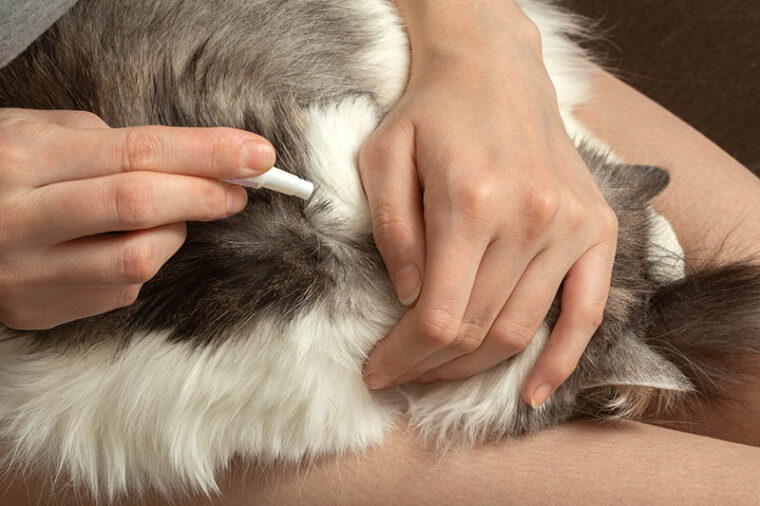
There are different ways to treat and prevent fleas but take time to do diligent research before applying any product to your pet. Some flea treatments pose substantial risks to cats, and you must be extremely careful not to apply any flea control product meant for dogs because they can contain ingredients that can be toxic to your cat.
You also want to avoid petting your cat immediately after certain flea treatments to avoid getting the product on yourself or reducing the effectiveness of it. So how soon after flea treatment can you pet your cat? The amount of time in which you can pet your cat after flea treatment just depends on the type of flea treatment. Here are 6 of the most common flea treatments, how they work, and how soon you can pet your cat after the treatment.
The 6 Common Flea Treatments
1. Oral
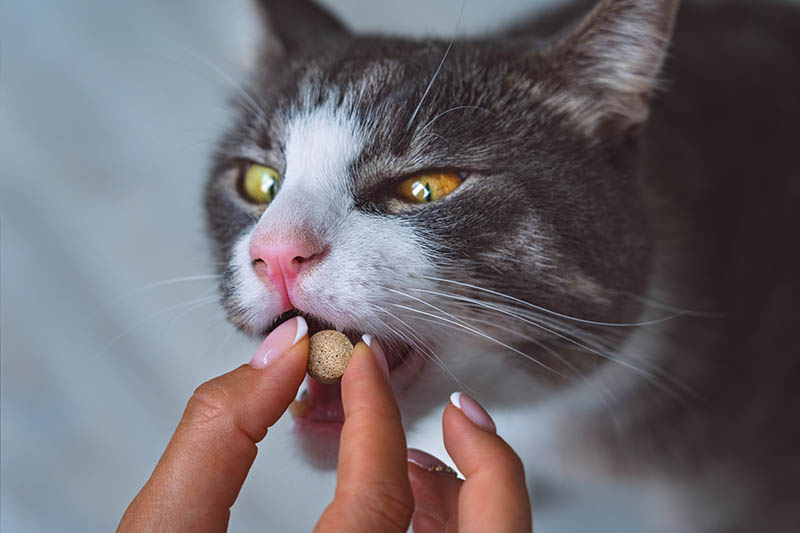
| Example: | Capstar |
| Generic Name: | Nitenpyram |
| How Soon Can I Pet My Cat: | Immediately |
| Benefits: | Kills adult fleas within a few hours |
| Risks: | Doesn’t repel fleas or kill flea eggs, larvae, or immature fleas; can cause side effects |
Used for cats and dogs, Capstar tablets release insecticides in your pet’s body which are rapidly excreted through their skin, killing 90% of adult fleas within hours. Since this is an oral tablet that works from the inside out, you can pet your cat immediately after giving the tablet to your cat. You’ll still need to clean your cat’s fur with a flea comb and soapy water after the medicine has taken effect to remove the dead fleas and any residual flea dirt. It won’t kill flea eggs, so you might also want to bathe your cat to remove any eggs the fleas might have laid if you suspect they’ve been on your cat for longer than a few hours.
We like the oral method because it works quickly and doesn’t linger in your pet’s system. However, like with any drug, there are possible side effects. Your cat may experience side effects from Capstar such as hypersalivation, vomiting, difficulty breathing, or any from this complete list.
You should be careful not to give Capstar tablets to any animal under 2 pounds or younger than 4 weeks old because of a higher likelihood for severe side effects. Additionally, never feed a cat any flea or tick prevention meant for dogs because some ingredients aren’t safe for both species and can kill your cat.
2. Topical
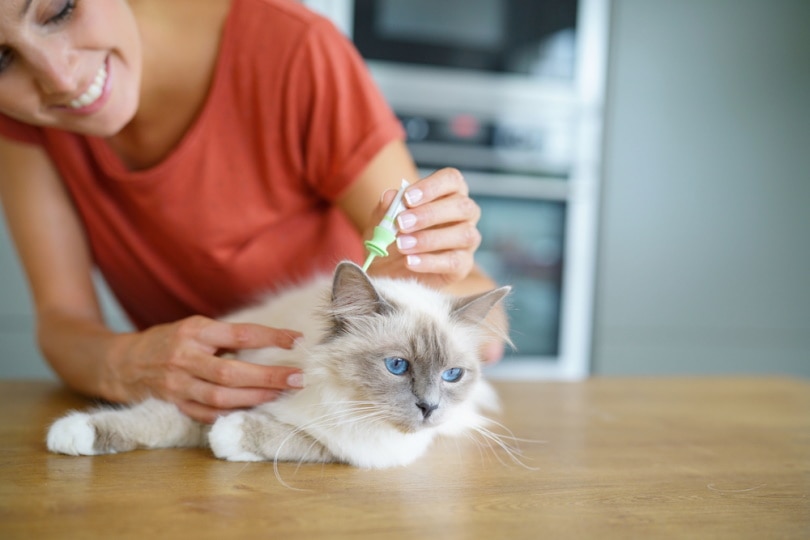
| Example: | Revolution, Frontline Plus |
| Generic Name: | Fipronil, Selamectin, (S)-methoprene, Pyriproxyfen |
| How Soon Can I Pet My Cat: | 24-48 hours |
| Benefits: | Kills fleas for 30 days; Frontline Plus kills eggs |
| Risks: | May not repel fleas; Toxic to humans with a long list of possible side effects for cats |
Topical solutions that you apply to the base of your cat’s neck are the most common flea control solutions for felines, but you might want to think again before you apply the gel for you and your cat’s safety. Although Revolution has been successfully used in clinical trials on pregnant cats, Selamectin is the main ingredient and its material safety data sheet reveals a high level of toxicity to reproductive organs, the liver, and any developing fetuses. Selamectin is toxic to humans, and so are all the other chemicals, which can cause a long range of effects, especially in small children. The other drugs aren’t any better. Pyripoxyfen in Frontline Plus also harms fetuses and reproductive organs, and fipronil can cause seizures and death.
Pet parents like topical gels because it kills any existing fleas and tackles the problem for a month, killing any fleas on contact before they get the chance to lay eggs. We understand the urge to find a quick and effective flea treatment if you suddenly see them hopping across your mattress, but we’re deeply concerned about massaging chemical pesticides into your cat’s fur because that exposes your pets, your home, and yourself to dangerous toxins that can have life-long effects.
These products actually don’t repel fleas, and it’s estimated that for every 1 flea on your animal, there are 9 more lurking in your carpets, bedding, and yard, so we don’t suggest relying on a topical gel to fix your flea problem. However, many cats do safely use Frontline and Revolution, so if you truly have an infestation on your hands, you might choose a topical pesticide as a last resort. Just wait 24-48 hours to pet your cat after applying and keep them off your pillows.
3. Flea Shampoo
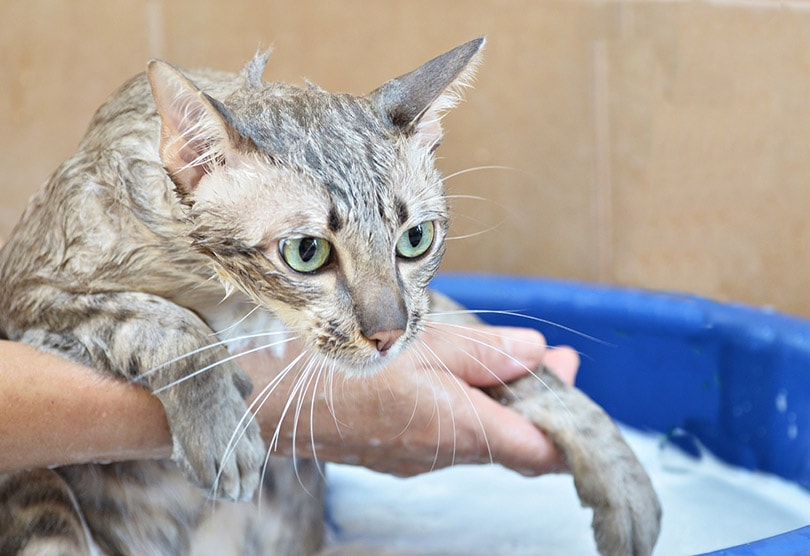
| Example: | Adams |
| Generic Name: | Pyrethrins, S-Methoprene, Piperonyl Butoxide, |
| How Soon Can I Pet My Cat: | As soon as they’re rinsed |
| Benefits: | Kills adult fleas and flea eggs; Controls flea eggs for 28 days |
| Risks: | Cats can be extremely sensitive to Pyrethrins, which are toxic in large doses or prolonged exposure |
While flea shampoo might not pose as much of a risk as a topical gel, it’s worth noting that you should never use a flea shampoo that’s formulated specifically for dogs on your cat. Most chemical flea shampoos contain some level of pyrethrins, but shampoos that are formulated for cats will either exclude this ingredient or include it at a lower dose than flea shampoos that are intended for use in dogs.
Pyrethrins are actually derived from the chamomile plant but can be toxic to cats. The exact amount isn’t known, either, because every cat’s tolerance is different. You also shouldn’t bathe a cat in flea shampoo more than once a week during an active infestation, or more than once a month for maintenance because it can dry out their coat.
If you decide to bathe your cat in a chemical flea shampoo, you probably want to wear gloves because the material safety data sheet for pyrethrins cautions against skin contact and recommends that you wear a mask if you’re using it in a poorly ventilated area. But, you can pet your cat as soon as all the shampoo has been rinsed out.
4. Flea Collars
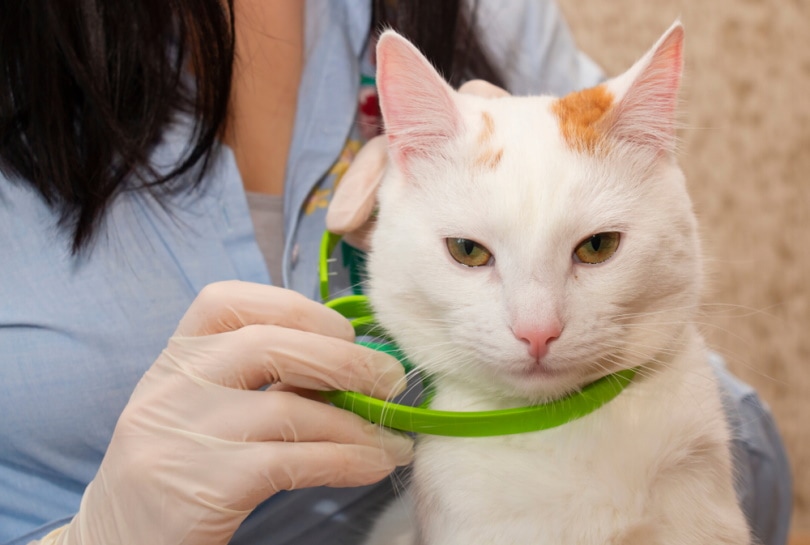
| Example: | Seresto |
| Generic Name: | Flumethrin, Imidacloprid |
| How Soon Can I Pet My Cat: | Immediately |
| Benefits: | Kills fleas for 8 months |
| Risks: | Highly toxic |
If your cat is wearing a flea collar, you can pet them immediately, just make sure to avoid touching the collar. However, there are some issues with flea collars. While customer reviews show that flea collars actually are highly effective at reducing the flea populations that can cling to your kitty, research has also shown that the two active ingredients are highly toxic to dogs, cats, and humans.
According to the Center for Biological Diversity, the Environmental Protection Agency (EPA) has received over 75,000 calls concerning the adverse effects coming from flea collars. Seresto, the main company that manufactures flea collars, has been blamed for 2,500 pet deaths resulting from these collars. Despite this, Seresto has faced no recalls or charges as of August 2022.
However, several animal rights groups such as PETA and the mainstream media are finally starting to jump on board with petitions for a ban. Canada has already banned the product, and activists are trying to get the U.S. to follow suit. While Seresto might kill all the fleas on your cat, we strongly caution against using this product for flea control (or anything else).
5. Natural Flea Repellent

| Example: | Vet’s Best, Wondercide |
| Active Ingredients: | Essential Oil Blend |
| How Soon Can I Pet My Cat: | Immediately |
| Benefits: | Natural solution that repels and sometimes kills fleas |
| Risks: | May not completely control the problem; Some essential oils are toxic to cats |
The safest way to both kill and repel fleas in your home is through an essential oil spray such as the ones made by Vet’s Best or Wondercide. You’ll just need to take extra care not to spray even a natural flea repellent that’s meant for canines on your cat because some essential oils that are safe for dogs are highly toxic to cats, such as peppermint oil. But, since these flea repellents contain natural ingredients and are free of harsh chemicals, you can pet your cat immediately after using them.
If you have an active flea problem, read the label to make sure the product also kills fleas on contact, not just repelling them. Spritz the spray against the grain of your cat’s fur, specifically targeting fleas if you find them crawling as you spray. Essential oils are great at killing fleas on contact but may not be the harshest form of treatment. You’ll likely still have to use a flea comb and some soapy water to get the job done.
6. Flea Comb
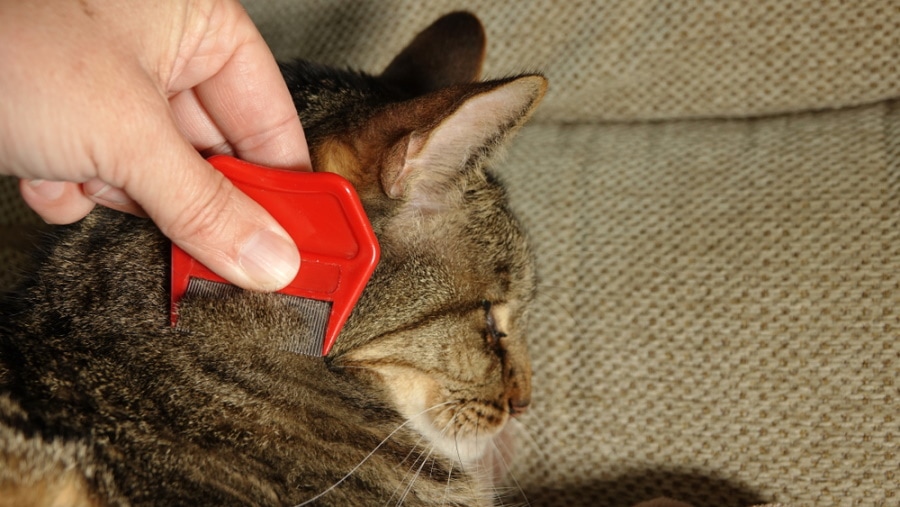
| Materials: | Flea comb, dish soap, water, a small jar for dunking the comb |
| How Soon Can I Pet My Cat: | Immediately, even during treatment |
| Benefits: | Kills fleas without harsh chemicals; Removes flea dirt from your cat’s skin |
| Risks: | Over-use of dish soap may dry your cat’s coat |
Killing fleas with a flea comb dipped in a solution of dish soap and water for the safest, cheapest solution to your flea problem. You can pet your cat while using this method, which may be more soothing for him. Comb against the grain, picking up fleas and flea dirt as you go. As soon as you spot a live flea, dunk it in the soapy water. Fleas can swim in plain water, but the dish soap breaks up the surface tension on the water’s surface, making them drown. While it’s okay to expose your cat’s skin to dish soap, make sure you don’t give them baths in dish soap too often or you might dry out their coat.
 Other Ways to Fight Fleas in Your Home and Yard
Other Ways to Fight Fleas in Your Home and Yard
If you have fleas on your cat, you can bet they’re hopping around your home and yard. You’ll need to counter the problem with vigilance and full force to eradicate the fleas and make sure they don’t return. Here are some suggestions:
Conclusion
Fleas are pesky pests that are exceedingly difficult to control. They can pose a danger to you and your pets, so you should find the best method to fix the problem as soon as possible so that you and your cat can enjoy more snuggles together. Just make sure that you wait the appropriate amount of time after treating your cat to pet him or her.
See Also:
- Can Cats Get Fleas in the Winter? Vet Reviewed Facts & FAQ
- Will Bleach Kill Fleas? Vet Reviewed Facts & FAQ
Featured Image Credit: tugol, Shutterstock

 Other Ways to Fight Fleas in Your Home and Yard
Other Ways to Fight Fleas in Your Home and Yard




